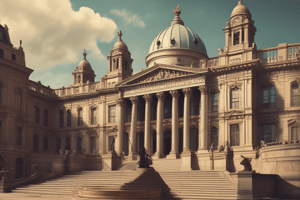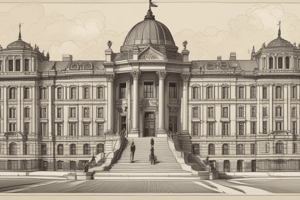Podcast
Questions and Answers
What is a primary purpose of declaratory relief under s. 24(1)?
What is a primary purpose of declaratory relief under s. 24(1)?
- To rectify constitutional deficiencies (correct)
- To provide financial compensation to the claimant
- To punish the state for constitutional breaches
- To directly alter the executive's powers
Which remedy under s. 24(1) is considered appropriate in the 'clearest of cases'?
Which remedy under s. 24(1) is considered appropriate in the 'clearest of cases'?
- Stay of proceedings (correct)
- Mandamus
- Damages
- Injunctive relief
Which of the following is NOT a purpose for which damages may be awarded under s. 24(1)?
Which of the following is NOT a purpose for which damages may be awarded under s. 24(1)?
- Deterrence of further breaches
- Punitive damages against state actors (correct)
- Vindication of Charter rights
- Compensation for personal loss
In what situation is mandamus available under s. 24(1)?
In what situation is mandamus available under s. 24(1)?
What does the prohibition on publishing representations aim to prevent?
What does the prohibition on publishing representations aim to prevent?
What was the primary allegation made by the four individuals to the Human Rights Commission regarding the flyers?
What was the primary allegation made by the four individuals to the Human Rights Commission regarding the flyers?
According to the findings of the Commission, how did the flyers violate s. 14 of the Saskatchewan Human Rights Code?
According to the findings of the Commission, how did the flyers violate s. 14 of the Saskatchewan Human Rights Code?
What was the basis of Whatcott's argument regarding s. 14 of the Saskatchewan Human Rights Code?
What was the basis of Whatcott's argument regarding s. 14 of the Saskatchewan Human Rights Code?
Which of the following statements best summarizes the conclusion reached about s. 14(1)(b) of the Code?
Which of the following statements best summarizes the conclusion reached about s. 14(1)(b) of the Code?
Which section of the Charter did Whatcott invoke to argue against the limitations imposed by s. 14?
Which section of the Charter did Whatcott invoke to argue against the limitations imposed by s. 14?
What is the primary objective of the public health measures discussed in the Gateway Bible Baptist Church case?
What is the primary objective of the public health measures discussed in the Gateway Bible Baptist Church case?
Which aspect of Manitoba's restrictions is highlighted as a significant benefit?
Which aspect of Manitoba's restrictions is highlighted as a significant benefit?
What logical rationale supports the restrictions on gatherings in the Gateway Bible Baptist Church case?
What logical rationale supports the restrictions on gatherings in the Gateway Bible Baptist Church case?
What is indicated as a critical element in the assessment of public health orders in the context of the pandemic?
What is indicated as a critical element in the assessment of public health orders in the context of the pandemic?
In the Taylor v. Newfoundland and Labrador case, what was the main justification for travel restrictions?
In the Taylor v. Newfoundland and Labrador case, what was the main justification for travel restrictions?
How does Manitoba's approach intend to manage the healthcare system during the pandemic?
How does Manitoba's approach intend to manage the healthcare system during the pandemic?
What assertion does the court make regarding religious freedoms in the context of public health orders?
What assertion does the court make regarding religious freedoms in the context of public health orders?
What overarching theme unites the cases of Gateway Bible Baptist Church and Taylor v. Newfoundland and Labrador?
What overarching theme unites the cases of Gateway Bible Baptist Church and Taylor v. Newfoundland and Labrador?
What was the primary rationale for the $5,000 income threshold selection?
What was the primary rationale for the $5,000 income threshold selection?
What was one significant argument against including CPP-D benefits in the income calculation?
What was one significant argument against including CPP-D benefits in the income calculation?
What was the government's pressing objective in enacting the measures to clear blockades?
What was the government's pressing objective in enacting the measures to clear blockades?
Which of the following was a limitation noted regarding the scope of the Declaration and the measures?
Which of the following was a limitation noted regarding the scope of the Declaration and the measures?
What was one possible outcome of suspending bank accounts under the enacted measures?
What was one possible outcome of suspending bank accounts under the enacted measures?
What was emphasized regarding the benefits of the impugned programs?
What was emphasized regarding the benefits of the impugned programs?
What type of legislative tools did authorities use to address blockades in certain areas?
What type of legislative tools did authorities use to address blockades in certain areas?
Which of the following statements about the temporary, emergency income replacement is accurate?
Which of the following statements about the temporary, emergency income replacement is accurate?
What is the significance of section 52(1) of the Constitution Act, 1982?
What is the significance of section 52(1) of the Constitution Act, 1982?
What type of remedy does section 24(1) of the Charter provide?
What type of remedy does section 24(1) of the Charter provide?
What was the outcome for Mr. Power regarding his application for a record suspension?
What was the outcome for Mr. Power regarding his application for a record suspension?
Which statement accurately reflects the nature of the language in section 52(1)?
Which statement accurately reflects the nature of the language in section 52(1)?
In the context of R v. Power, what does section 11(h) and (i) of the Charter pertain to?
In the context of R v. Power, what does section 11(h) and (i) of the Charter pertain to?
What can be inferred about the consequences of the measures affecting suspended accounts?
What can be inferred about the consequences of the measures affecting suspended accounts?
How does the role of section 52(1) differ from section 24(1) of the Charter?
How does the role of section 52(1) differ from section 24(1) of the Charter?
Which of the following best describes the impact of retrospective legislation in Mr. Power's case?
Which of the following best describes the impact of retrospective legislation in Mr. Power's case?
Flashcards are hidden until you start studying
Study Notes
Judicial Review and Balancing of Rights
-
Gateway Bible Baptist Church et al. v. Manitoba et al., 2021 MBQB 219: This case involved the challenge to public health measures aimed at limiting the spread of COVID-19, specifically restrictions on gatherings in places of worship.
- The court upheld the restrictions, finding that they were justified under the Charter's limitations clause (section 1) due to the pressing and substantial objective of protecting public health.
- The court emphasized the rational connection between the restrictions and the objective, stating that measures like limiting gatherings were rationally connected to reducing the spread of COVID-19.
- The court considered the measures to be proportionate, meaning that they were not overly intrusive on the right to religious freedom.
-
Taylor v. Newfoundland and Labrador, 2020 NLSC 125: This case involved a challenge to travel restrictions and income support programs implemented during the COVID-19 pandemic.
- The court upheld the travel restrictions, finding that the government's objective of protecting public health outweighed the individual's right to travel.
- The court also found that the income support programs were reasonably tailored to achieve the objective of providing temporary financial assistance to workers affected by the pandemic.
-
Canadian Frontline Nurses et al. v. Canada, 2024 FC 42: This case involved the challenge to the use of the Emergencies Act to address the "Freedom Convoy" protests in 2022.
- The court upheld the government's use of the Emergencies Act, finding that the government had a pressing and substantial objective in clearing out the blockades.
- The court found a rational connection between the objective and the measures, particularly the freezing of bank accounts, to stop funding the blockades.
- The court did express concern about the scope of the measures, suggesting that they could have been more narrowly tailored to address the situation in specific areas.
Section 52 (1) and Section 24 (1) of the Constitution Act, 1982
-
Section 52(1): This section establishes the Constitution as the supreme law of Canada. Any law inconsistent with the Constitution is deemed to be of no force or effect.
- This section applies to legislation and government policies that are legislative in nature.
- Section 52(1) operates on a mandatory basis, meaning that any law found to be inconsistent with the Constitution is automatically invalid.
-
Section 24(1): This section provides remedies for individuals whose Charter rights have been infringed or denied.
- The court has discretion in determining what remedy is appropriate and just in the circumstances.
Charter Remedies
- There are multiple ways in which the courts can provide remedies for Charter violations.:
- Declaratory Relief: This involves a declaration from the court that a law or government action is unconstitutional.
- Damages: This provides compensation for the harm caused by the violation.
- Mandamus: This requires a government body to perform a specific legal duty.
- Stay of Proceedings: This involves pausing legal proceedings until a Charter violation is resolved.
- Injunctive Relief: This prevents a government body from taking a specific action that is considered unconstitutional.
Key Case Examples
-
R v. Power, 2024 SCC 26: This case involved a challenge to changes to the Criminal Records Act that retrospectively made certain individuals permanently ineligible for a record suspension.
- The court found that these changes violated section 11 of the Charter, which guarantees the right to be tried in accordance with the principles of fundamental justice.
- The court issued a declaration that the provisions were of no force and effect, meaning they were invalid.
-
Whatcott v. Saskatchewan Human Rights Commission: This case involved a challenge to the Saskatchewan Human Rights Code, which prohibits hate speech.
- The court upheld the Code's prohibition on hate speech but struck down certain wording as overly broad and not sufficiently related to the legislative purpose.
- The court held that the Code must be interpreted narrowly to avoid infringing freedom of expression.
Studying That Suits You
Use AI to generate personalized quizzes and flashcards to suit your learning preferences.




